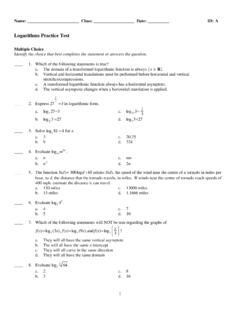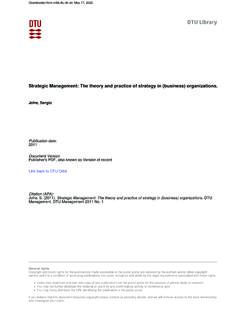Transcription of Transformational leadership - Langston
1 Transformational leadership1 Transformational leadershipTransformational leadership is defined as a leadership approach that causes change in individuals and socialsystems. In its ideal form, it creates valuable and positive change in the followers with the end goal of developingfollowers into leaders. Enacted in its authentic form, Transformational leadership enhances the motivation, moraleand performance of followers through a variety of mechanisms. These include connecting the follower's sense ofidentity and self to the mission and the collective identity of the organization; being a role model for followers thatinspires them; challenging followers to take greater ownership for their work, and understanding the strengths andweaknesses of followers, so the leader can align followers with tasks that optimize their MacGregor Burns (1978)[1] first introduced the concept of transforming leadership in his descriptive researchon political leaders, but this term is now used in organizational psychology as well.
2 According to Burns,transforming leadership is a process in which "leaders and followers help each other to advance to a higher level ofmorale and motivation". Burns related to the difficulty in differentiation between management and leadership andclaimed that the differences are in characteristics and behaviors. He established two concepts: "transformingleadership" and "transactional leadership ". According to Burns, the transforming approach creates significant changein the life of people and organizations. It redesigns perceptions and values, and changes expectations and aspirationsof employees. Unlike in the transactional approach, it is not based on a "give and take" relationship, but on theleader's personality, traits and ability to make a change through example, articulation of an energizing vision andchallenging goals.
3 Transforming leaders are idealized in the sense that they are a moral exemplar of working towardsthe benefit of the team, organization and/or community. Burns theorized that transforming and transactionalleadership were mutually exclusive styles. Transactional leaders usually do not strive for cultural change in theorganization but they work in the existing culture while Transformational leaders can try to change of conceptAnother researcher, Bernard M. Bass (1985), extended the work of Burns (1978) by explaining the psychologicalmechanisms that underlie transforming and transactional leadership ; Bass also used the term " Transformational "instead of "transforming." Bass added to the initial concepts of Burns (1978) to help explain how transformationalleadership could be measured, as well as how it impacts follower motivation and performance.
4 [2] The extent to whicha leader is Transformational , is measured first, in terms of his influence on the followers. The followers of such aleader feel trust, admiration, loyalty and respect for the leader and because of the qualities of the transformationalleader are willing to work harder than originally expected. These outcomes occur because the Transformational leaderoffers followers something more than just working for self gain; they provide followers with an inspiring missionand vision and give them an identity. The leader transforms and motivates followers through his or her idealizedinfluence (earlier referred to as charisma), intellectual stimulation and individual consideration.
5 In addition, thisleader encourages followers to come up with new and unique ways to challenge the status quo and to alter theenvironment to support being successful. Finally, in contrast to Burns, Bass suggested that leadership cansimultaneously display both Transformational and transactional 30 years of research and a number of meta-analyses have shown that Transformational and transactionalleadership positively predicts a wide variety of performance outcomes including individual, group and organizationallevel variables (see Bass & Bass 2008, The Bass Handbook of leadership : Theory, Research, and ManagerialApplications" 4th edition Free Press).The full range of leadership introduces four elements of Transformational leadership : Transformational Consideration the degree to which the leader attends to each follower's needs, acts as a mentoror coach to the follower and listens to the follower's concerns and needs.
6 The leader gives empathy and support,keeps communication open and places challenges before the followers. This also encompasses the need forrespect and celebrates the individual contribution that each follower can make to the team. The followers have awill and aspirations for self development and have intrinsic motivation for their Stimulation the degree to which the leader challenges assumptions, takes risks and solicitsfollowers' ideas. Leaders with this style stimulate and encourage creativity in their followers. They nurture anddevelop people who think independently. For such a leader, learning is a value and unexpected situations are seenas opportunities to learn. The followers ask questions, think deeply about things and figure out better ways toexecute their Motivation the degree to which the leader articulates a vision that is appealing and inspiring tofollowers.
7 Leaders with inspirational motivation challenge followers with high standards, communicate optimismabout future goals, and provide meaning for the task at hand. Followers need to have a strong sense of purpose ifthey are to be motivated to act. Purpose and meaning provide the energy that drives a group forward. Thevisionary aspects of leadership are supported by communication skills that make the vision understandable,precise, powerful and engaging. The followers are willing to invest more effort in their tasks, they are encouragedand optimistic about the future and believe in their Influence Provides a role model for high ethical behavior, instills pride, gains respect and a development tool, Transformational leadership has spread already in all sectors of western societies, includinggovernmental organizations.
8 As an example, the Finnish Defence Forces is using widely Deep Lead Model as basicsolution of its leadership training and development. The Deep Lead Model is based on the theory oftransformational in the areaWhen researching Transformational and transactional leadership the most frequently used survey is called "theMultifactor leadership Questionnaire" (MLQ Form 5X). This is a questionnaire that measures each of thecomponents of the full range of leadership , initially starting with Bass' (1985) factors and analysis. The originalscales in the questionnaire are based on a initial factor analysis and earlier research on Transformational leadership was limited, because the knowledge in this area was too primitive forfinding good examples for the items in the questionnaire.
9 Another weakness in the first version of the MLQ relatedto the wording of items. Most items in the scale of charismatic leadership described the result of leadership , insteadof specific actions of the leader that can be observed and that, in turn, lead to the results. In response to the critics,Bass and Avolio (1990) included in the revised and now subsequent versions many more items that describeleadership actions that are observed directly. They also split out attributions of leadership associated with IdealizedInfluence and behaviors and actions into two separate current version of the MLQ Form 5X includes 36 items that are broken down into 9 scales with 4 itemsmeasuring each scale. Subsequent validation work by John Antonakis and his colleagues provided strong evidencesupporting the validity and reliability of the MLQ5X.
10 [3] Indeed, Antonakis et al. (2003) confirmed the viability of theproposed nine-factor model MLQ model, using two very large samples (Study 1: N=3368; Study 2: N=6525).Although other researchers have still been critical of the MLQ model, since 2003 none has been able to providedis-confirming evidence of the theorized nine-factor model with such large sample sizes at those published byAntonakis et al. (2003). Transformational leadership3 Implications for managersYukl (1994) draws some tips for Transformational leadership [4] a challenging and attractive vision, together with the the vision to a strategy for its the vision, specify and translate it to confidence, decisiveness and optimism about the vision and its the vision through small planned steps and small successes in the path for its full [1]Burns, , (1978), leadership , , Harper and Row.




